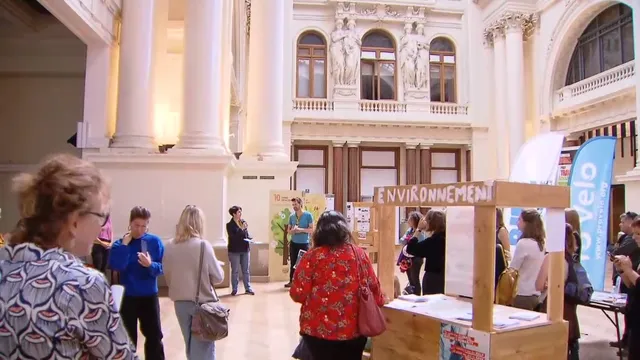The renovated Beursgebouw will probably open its doors this summer. Not just for tourists and visitors to the Belgian Beer Museum. With the opening of the building, the city suddenly gains 16,000 square meters of public space. As of today, some forty organizations are considering its implementation.
The stairs of the Beurs are the meeting place for many people. They are perhaps the heart of Brussels, thinks Nel Vandevannet, the director of the municipal project to renovate the Stock Exchange. The building itself has always remained closed to the public. Although the massive structure was owned by the City of Brussels, it was leased to Euronext.
When the European stock exchange company moved in 2015, the City of Brussels decided to renovate and open the building. That is to say: it will have a mixed function with private and public players. Some of the activities are already set: think of the Belgian Beer Museum or the roof terrace and Bruxella 1238, the archaeological museum of the City of Brussels.
But most of it, including the main hall, becomes public domain. Just as the stairs used to be the heart of the city, the building must take over that function. “It must become the space of the people of Brussels,” says Vandevannet. “What identity are we going to create, what is going to happen here? We like to hear that from a very mixed audience.”
Three workshops
In a series of three workshops, the municipality and about forty organizations will look for answers to these questions. A balance has been sought between representatives in various domains: think of the social sector, the academic world and residents’ and trades associations.
In concrete terms, the city makers Urban Foxes are involved in the process, as are the city experts of Brukselbinnenstebuiten, the homeless organization Diogenes, boxing club Jah Boxing, Cinema Palace, Francisco Ferrer college, various primary schools in the area, the Sint-Jacobswijk and Darna association, the Flemish-Moroccan culture house .
The organizations received an invitation in the mail to help think about the details of the Beursgebouw. They do that during those three workshops. On Friday they will discuss the identity of the Fair, then the various actions or initiatives that could take place there and finally, in May, the practical implementation.
Theater or Contemporary Art?
Will the space be open to theater performances, street musicians or exhibitions by world-famous artists? “That will have to become apparent during the process,” says Arnaud Pinxteren (Ecolo) alderman of Citizen Participation, who set up and will supervise the participation process with the organizations. It is already clear that there will be public toilets for men and women, and even a public shower. It is still too early for concrete agreements about safety or nuisance.
Similar projects already exist abroad. For ships Pinxteren, the French Centquatre-Paris is an example. This is also a public space that is home to artists in residence, among others. Parisians can also admire the work of contemporary artists on display for free.
This article is originally published on bruzz.be




